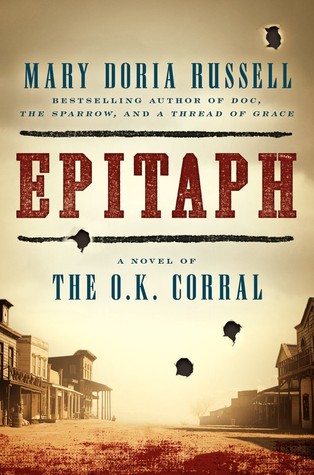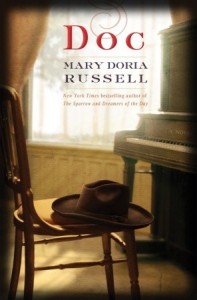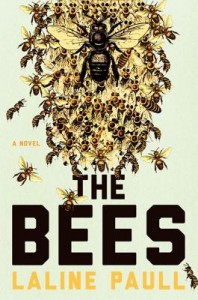 Format read: ebook provided by the publisher via Edelweiss
Format read: ebook provided by the publisher via EdelweissFormats available: hardcover, paperback, ebook, audiobook
Genre: historical fiction
Length: 592 pages
Publisher: Ecco
Date Released: March 3, 2015
Purchasing Info: Author’s Website, Publisher’s Website, Goodreads, Amazon, Barnes & Noble, Kobo, Book Depository
A deeply divided nation. Vicious politics. A shamelessly partisan media. A president loathed by half the populace. Smuggling and gang warfare along the Mexican border. Armed citizens willing to stand their ground and take law into their own hands…
That was America in 1881.
All those forces came to bear on the afternoon of October 26th when Doc Holliday and the Earp brothers faced off against the Clantons and the McLaurys in Tombstone, Arizona. It should have been a simple misdemeanor arrest. Thirty seconds and thirty bullets later, three officers were wounded and three citizens lay dead in the dirt.
Wyatt Earp was the last man standing, the only one unscathed. The lies began before the smoke cleared, but the gunfight at the O.K. Corral would soon become central to American beliefs about the Old West.
Epitaph tells Wyatt’s real story, unearthing the Homeric tragedy buried under 130 years of mythology, misrepresentation, and sheer indifference to fact. Epic and intimate, this novel gives voice to the real men and women whose lives were changed forever by those fatal 30 seconds in Tombstone. At its heart is the woman behind the myth: Josephine Sarah Marcus, who loved Wyatt Earp for forty-nine years and who carefully chipped away at the truth until she had crafted the heroic legend that would become the epitaph her husband deserved.
My Review:
Epitaph is the story behind 30 seconds in the 19th century American West that live in myth and legend. 30 seconds that haunt the remaining years of the last survivor well into the 20th.
 Where the absolutely marvelous Doc (reviewed here) relates the story of John Henry “Doc” Holliday in the years before he and the Earp Brothers, found themselves in Tombstone, Epitaph becomes, quite literally, the epitaph of Wyatt Earp, the last survivor of that bloody half-minute.
Where the absolutely marvelous Doc (reviewed here) relates the story of John Henry “Doc” Holliday in the years before he and the Earp Brothers, found themselves in Tombstone, Epitaph becomes, quite literally, the epitaph of Wyatt Earp, the last survivor of that bloody half-minute.
The title is also a terribly fitting pun. The Tombstone Arizona newspaper that covered the Gunfight at the O.K. Corral most insistently, and whose editor helped to incite the shootout, was the Tombstone Epitaph. Because, as the masthead famously stated, “Every Tombstone needs an Epitaph.”
The story of the famous gunfight, as told in this account, seems like layer upon layer of competing “spin”, culminating in a mostly fictionalized quasi-biography of Wyatt Earp that was published as fact during the Depression, over 50 years after the events.
Although it claimed to be based on Wyatt Earp’s recollections, it was probably mostly made up by the author, Stuart Lake. But it, and the movie based on it, and the TV show based on that, turned out to be not just perfect for the Depression, but also eventually perfect for the fledgling TV industry.
We’ll get back to that.
Most of the book is about the Earps’ and Doc Holliday’s, unfortunate decision to move to Tombstone and the two years worth of catastrophes that followed. Tombstone was a boomtown, with all of the lawlessness that name implies. The Earps, as a group, tended to become sheriffs or deputies or otherwise be on the side of law and order. They enforced the law so that some order could be maintained.
It was what they had done in Dodge City, but it turned out disastrously for them in Tombstone.
The opposition, not just in the gunfight but in the years previously, was a group that called themselves “Cow-boys”. These were not working cowhands, or ranchers. This was a group of men that made their living by stealing cows from across the Mexican border, and from other Arizona ranches, and then re-selling them to the Army or to the silver mines. They raped, murdered and generally pillaged, but Tombstone could never manage to convict any of them of anything.
They had bought off the judges, and terrorized the townspeople. No one stood against them, except the Earps. And that stand is what eventually got everyone involved killed. Some at the gunfight, but most in revenge afterwards.
After all of the dust had finally settled, months and multiple conflicting accounts later, Wyatt was the only survivor. The last third of the book is about Wyatt’s journey after his friends, his brothers and his enemies had died – many of the enemies at his own hand.
His story starts in one last reach for glory, and ends in obscurity.
Escape Rating B: I absolutely loved Doc, and was hoping for more of the same in Epitaph. While I enjoyed Epitaph, it didn’t work as well for me as Doc.
Partly it’s that we know more about the Gunfight at the O.K. Corral, even if what we know is wrong. We all have a pretty good idea of how this story is going to end, even if we don’t know the details of how they get there.
Because Doc takes place earlier, the devastating ending is still in the shadows, we don’t have to confront it. At the same time Doc Holliday is different character than Wyatt Earp. Doc was educated and especially articulate. He was also fully conscious of the ironies of his situation. His head is a more interesting perspective. And Doc’s story is going to end in tragedy no matter what happens – there was no effective treatment for tuberculosis in the 1870’s.
A lot of the story in Tombstone involves the lining up of the various factions. No one involved on either side seems to have been telling much of the truth, or even much of a consistent story. What we do see is the lining up of the “town” faction, always on the side of at least some kind of order, if not exactly law, and the ranchers on the opposite side who saw town as a place to cut loose, no matter how violently, when they wanted to let off a little steam. They did not want the town’s need for rules or law to impinge on their fun, or on their rights in the territorial legislature.
In some ways, it is easy to see the Gunfight at the O.K. Corral as one of the last signposts on the history of the end of the “Wild West”. While the initial picture is very confused, and both sides go on a spree of killing vengeance, in the end, civilization wins.
The focus of the story before the fight is on the Earps, and Doc by extension. We get involved in all of their lives, and come to understand just how they ended up where and how they did. But there is a lot of foreshadowing in the beginning of the story, and it feels heavy-handed. So heavy-handed that it breaks the fourth wall, and feels as though the author is speaking directly to the reader rather than telling the story.
The end felt dragged out. The last third of the book is Wyatt and his wife Josie’s journey all over the West, trying to find a place to settle and outrun or outlive his notoriety. It is both sad and anticlimactic, as Wyatt dies broke and Josie descends into dementia. That Wyatt’s history is whitewashed and reborn on TV is not something that either of them lives to see, even though the sanitized version is the one that Josie always wanted to be told.
Reviewer’s note: My first conscious exposure to the Gunfight at the O.K. Corral was a very bad Star Trek episode, Spectre of the Gun. In the episode, the Enterprise crew take the places of the Cow-boys, who in history were the villains of the piece. In the illusion they are stuck in, circumstances as somewhat otherwise. Of course.

